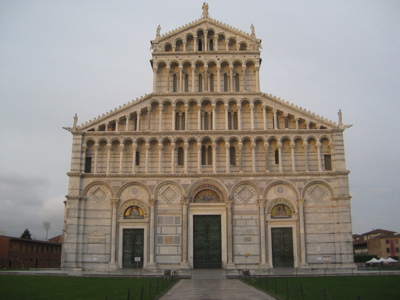The city of Pisa, on the western coast of Italy right where it starts to curve towards France, was a naval power of great wealth and importance.....in the 1200's. Pisa won a naval battle off Sicily in 1062 and the spoils of that victory funded the Pisan building program. This is what is today's "Piazza dei Miracoli" However, in 1284 Pisa lost a major battle, had it's overseas outposts taken away, the port silted up and it became kind of a backwater. But what we have left is a set of buildings that have their own style known as "Pisan Romanesque." It's grand, but also light and airy feeling.
The Baptistry, the Duomo and Campanile, three of the four buildings that comprise the complex.
Here it is, the leaning tower, and it really is almost at a 15 degree angle. I refused, however, to pose for one of those pictures where it looks like I'm holding it up. Way too cliche.
The baptistry!!
This pulpit, by Nicola (the father of the father/son duo) Pisano is in the baptistry. Built in 1260, this hexagonal shaped pulpit is like the one in Siena, it's showing classical forms and emerging realism.
Here is the interior of the baptistry from above. Notice the pulpit and the baptistry itself. The small holes are for baptising of babies. Also, the baptistry has AMAZING acoustics. A sound can reverberate for over 20 seconds. One cool thing is that someone can sing one note, then a second and then a third and since the first two are still reverberating, it sounds like there are three voices making a chord even though the three were produced by one person.
Pisan Romanesque!
The apse of the duomo is still of the Byzantine style. When this was constructed, art was in the transition from Byzantine to the emergence of the Renaissance.
This pulpit in the duomo was created by the younger Pisano, Giovanni between 1301-1311.
Let's compare a panel by the father in the baptistry....
...to one by the son in the duomo. You can see that Giovanni clearly learned from his Dad, but took things to an even greater extreme. He carves a deeper relief, adds more movement, has many more figures and has a sense of perspective that isn't yet fully developed in the panel done by his father. It was AWESOME to see these pulpits (along with the one in Siena).










No comments:
Post a Comment